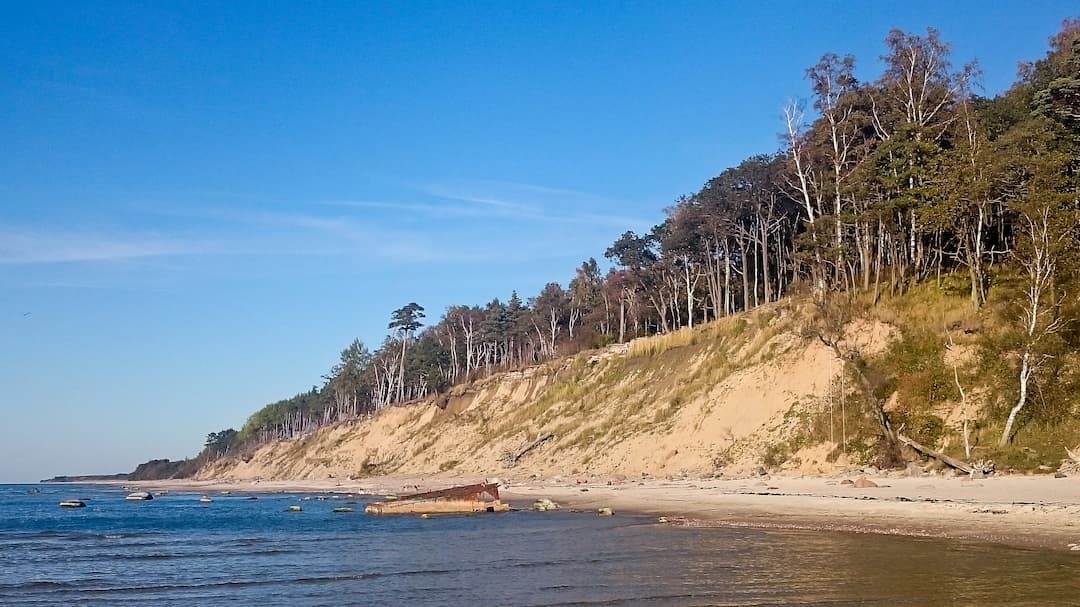Seaside route

Cycling enthusiasts will definitely appreciate the Western Lithuanian bicycle route stretching across the park. This is one of the most beautiful bicycle routes in Lithuania, which goes along Plazė Nature Reserve offering wonderful views of nature. Meanwhile divers will like the attractions offered by the sea – searching for sunken ships, enjoying the view of the stony bottom of the sea and the underwater fauna. The waters along Nemirseta conceal the sunken relic of the World War II – the German naval ship fusilier. Those interested in biology will experience the pleasure of diving along the Dutchman’s Cap, the area of which is rich with large boulders covered with algae and molluscs. Here you can see the bull-head, also known as the shorthorn sculpin, the lumpfish, lots of rockpool shrimps and round gobies.
From the cognitive point of view this part of our seaside is truly exceptional: in the relatively small area the visitors can find lots of rare plants, watch flocks of migratory birds in autumn and wintering birds in winter. This sensitive natural area, surrounded by urban territories, is also the breeding and nesting area for a number of birds included into the Red List of Lithuania – cranes, hoopoes, ringed plovers, Eurasian hobbies, common kestrels and white tailed sea eagles.
The Seaside Regional Park stretches along the coast of the Baltic Sea, which makes visits simple and it is impossible to get lost. The Park is one of the smallest parks in Lithuania and all places of interest can be easily accessed on foot in one day, although bicycling would be most convenient.
The Seaside Regional Park is one of the places, where visitors can enjoy historical sights and the nature without getting too far from the conveniences of civilisation. One of the simplest ways to get to know the valuables of the Park is simply to travel along the seaside, visiting all places of interest. The most convenient location to start is the World War II fortifications in Kukuliškės. Inside you will find a historical military exhibition and the enthusiasts of the local military club will take you on interesting tours. Further on you will travel through the forest, planted back in the early 20th century by Klaipėda Magistrate and the merchant guild. This forest looks more like a manor park, since the merchants decided to enrich the forest with imported trees – beeches, sycamore maples, red maples, silver firs and larches. This forest is easily accessible even for the youngest of visitors, easy to find, convenient for walks and difficult to get lost in. It stretches from the World War II fortifications along the Littorina Sea (the old title of the Baltic Sea) until the 24-metre-high Dutchman’s Cap cliff near Karklė. This stretch includes the so called Littorina route – a marked track with information stands about local valuables. From the Dutchman’s Cap you will shortly reach Karklė – the old historical fishermen’s village. The history of the location reflects on the old forest guard house (6), the cemetery of the drowned, the old forgery, school and the remainders of the church foundation. In Karklė there is a number of accommodation establishments, two shops (one of them sells fresh and smoked fish), a cafeteria, a restaurant and a mini zoo. More information about the places to visit is available at the Seaside Regional Park Visitor Centre.
Seaside Regional Park is rich with amber, in fact, it is is proud of one of the largest amber deposits. Locals used to use special scoop-nets for catching amber directly from the sea since the old days. This craft requires good knowledge of the nature and the area. Some amber catchers making amber souvenirs manage to earn a good living, while others also work as tour guides, teaching the craft of amber catching and introducing people to the history of amber.
Karklė has an excellent bicycle access to Palanga. On the way to Palanga travellers can visit Plazės Lake, equipped with a bird watching lookout. Even if you come here not during the bird migration period and there are no birds at all, the lookout opens to a breathtaking view of the natural coastal meadows with white dunes and the blue depths of the sea. The bicycle route stretches along the border of Plazė Reserve, the coastal side of which is forbidden to enter, but the visitors can enjoy the view of the seaside landscape, meadows, forests and dunes from the route. Just before Nemirseta, along Anaičiai village, there is an observation place, perfect for having a short rest. It opens to the view to the protected coastal habitats with rare plants. A bit further there is another observation place on the coast of Littorina Sea, opening a view to extraordinary beautiful natural dunes. Just 500 metres away from the observation place there is the ship rescue station built in the early 20th century – the only of its kind in Lithuania, that survived to our days. Another nearby place of interest is the cemetery of Anaičiai village. History lovers travelling further like to look for signs of the old border between Lithuania and Germany, and eventually the route ends in Palanga.